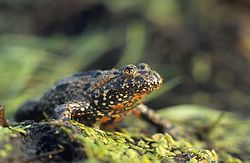| Toad | |
|---|---|
 | |
| European fire-bellied toad (Bombina bombina), a member of the family Bombinatoridae | |
| Scientific classification | |
| Kingdom: | Animalia |
| Phylum: | Chordata |
| Class: | Amphibia |
| Clade: | Salientia |
| Order: | Anura Merrem, 1820 |
| Families | |
Toad (also known as a hoptoad) is a common name for certain frogs, especially of the family Bufonidae, that are characterized by dry, leathery skin, short legs, and large bumps covering the parotoid glands. [1] [2]
Contents
In popular culture (folk taxonomy), toads are distinguished from frogs by their drier, rougher skin and association with more terrestrial habitats. [3] However, this distinction does not align precisely with scientific taxonomy.

